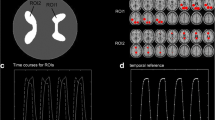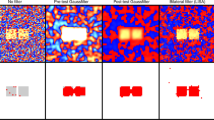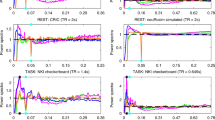Abstract
Independent component analysis (ICA) is a technique to separate the mixed signal into independent components without priori assumptions about the hemodynamic response to the task. Spatial ICA (SICA) is applied widely in fMRI data because the spatial dimension of fMRI data is larger than their temporal dimension. The general linear model (GLM) is based on a priori knowledge about stimulation paradigm. In our study, a two-task cognitive experiment was designed, and SICA and GLM were applied to analyze these fMRI data. Both methods could easily find some common areas activated by two tasks. However, SICA could also find more accurate areas activated by different single task in specific brain areas than GLM. The results demonstrate that ICA methodology can supply us more information or the intrinsic structure of the data especially when multitask-related components are presented in the data.
Access this chapter
Tax calculation will be finalised at checkout
Purchases are for personal use only
Preview
Unable to display preview. Download preview PDF.
Similar content being viewed by others
References
Andersen A.H., Gash D.M., Malcolm J.A. (1998) Principal component analysis of the dynamic response measured by fMRI: a generalized linear systems framework. Magn Reson Imaging 17: 795–815.
Bell A.J., Sejnowski T.J. (1995) An information-maximization approach to blind separation and blind deconvolution. Neural Computation 7:1129–1159.
Biswal B.B, Ulmer J.L. (1999) Blind source separation of multiple signal sources of fMRI data sets using independent component analysis. J. Comput. Assist. Tomogr 23: 265–271
Calhoun V. D., Adali T., Pearlson G.D., and Pekar J.J. (2001) Spatial and temporal independent component analysis of functional MRI data containing a pair of task-related waveforms. Hum. Brain Mapp 13: 43–53.
Chad H. M., Victor M. H., Dietmar C., Michelle Q., and M. E. M. (2000) Whole-brain functional MR imaging activation from a finger-typing task examined with independent component analysis. AJNR Am J Neuroradiol 21: 1629–1635.
Esposito F., Formisano E., Seifritz E., Goebel R., Morrone R., Tedeschi G., and Francesco D.S. (2002) Spatial independent component analysis of functional MRI time-series: to what extent do results depend on the algorithm used? Hum. Brain Mapp. 16: 146–157.
Friston, K. J. (1996) Statistical parametric mapping and other analyses of functional imaging data. Brain Mapping: The Methods (Toga A.W. and Mazziotta J.C., Eds.) [C]. San Diego: Academic Press, 363–396.
Hyvärinen A. (1999) Fast and robust fixed-point algorithms for independent component analysis. IEEE Trans Neural Networks 10: 626–634.
Hong Gu, Wolfgang Engelien, Hanhua Feng, David A. Silbersweig, Emily Stern, Yihong Yang. (2001) Mapping transient, randomly occurring neuropsychological events using independent component analysis. NeuroImage 14: 1432–1433.
Makeig S., Jung T.P., Bell A.J., Ghahremani D., Sejnowski T.J. (1997) Blind separation of auditory event-related brain responses into independent components. Proc. Natl. Acad. Sci. USA 94: 10979–10984.
Mckeown M. J., Makeig S., Brown G.G., Jung T.-P., Kindermann S. S., Bell A. J., and Sejnowski T. J. (1998a) Analysis of fMRI data by separation into independent spatial components. Hum. Brain Mapp. 6: 160–188.
Mckewon M. J., Jung T.-P., Makeig S., Brown G., Kindermann S. S., Lee, T.-W., and Sejnowski T. J. (1998b) Spatially independent activity patterns in functional MRI data during the stroop color-naming task. Proc. Natl. Acad. Sci. USA 95: 803–810.
Meckeown M. J. (2000) Detection of consistently task-related activations in fMRI data with hybrid independent component analysis. NeuroImage 11: 24–35.
Ogawa S., Tank D.W., Menon R., Ellermann J.M., Kim S.G., Merkle H., and Ugurbil K. (1992) Intrinsic signal changes accompanying sensory stimulation: Functional brain mapping with magnetic resonance imaging. Proc. Natl. Acad. Sci. USA 89: 5951–5955.
Author information
Authors and Affiliations
Editor information
Editors and Affiliations
Rights and permissions
Copyright information
© 2003 Springer-Verlag Berlin Heidelberg
About this paper
Cite this paper
Long, Zy. et al. (2003). Spatial Independent Component Analysis of Multitask-Related Activation in fMRI Data. In: Kaynak, O., Alpaydin, E., Oja, E., Xu, L. (eds) Artificial Neural Networks and Neural Information Processing — ICANN/ICONIP 2003. ICANN ICONIP 2003 2003. Lecture Notes in Computer Science, vol 2714. Springer, Berlin, Heidelberg. https://doi.org/10.1007/3-540-44989-2_61
Download citation
DOI: https://doi.org/10.1007/3-540-44989-2_61
Published:
Publisher Name: Springer, Berlin, Heidelberg
Print ISBN: 978-3-540-40408-8
Online ISBN: 978-3-540-44989-8
eBook Packages: Springer Book Archive




